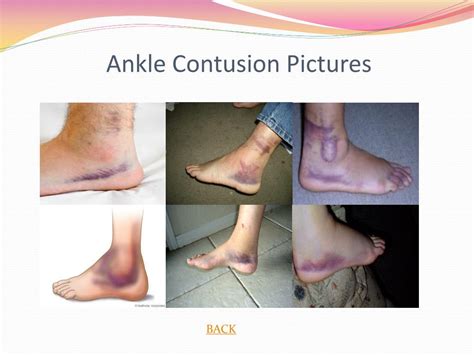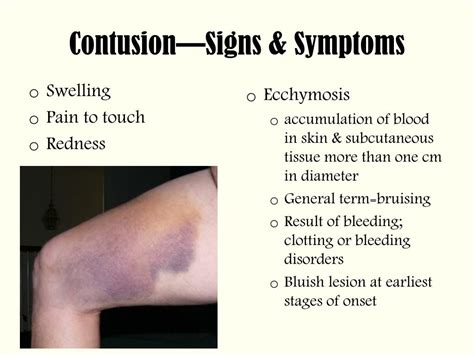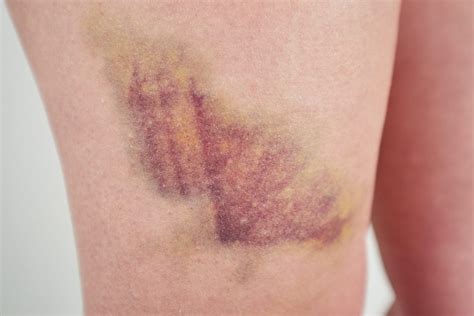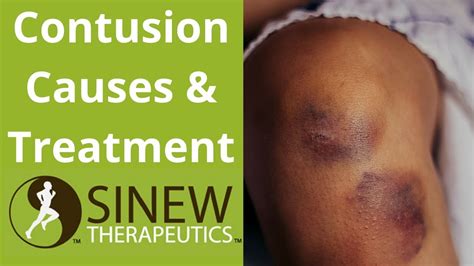Intro
Learn about contusion, a common injury causing bruising, swelling, and pain. Understand symptoms, treatment, and recovery from this soft tissue trauma, including related conditions like hematomas and sprains.
A contusion, also known as a bruise, is a type of injury that occurs when blood vessels are damaged, causing blood to leak into the surrounding tissue. This can happen as a result of a blow to the skin, a fall, or any other type of trauma. Contusions can range in severity from minor to severe, and they can affect anyone, regardless of age or health status. In this article, we will delve into the world of contusions, exploring their causes, symptoms, diagnosis, treatment, and prevention.
Contusions are one of the most common types of injuries, and they can occur in anyone who has experienced some type of trauma. Whether it's a minor bump or a severe blow, contusions can be painful and unsightly. However, with proper treatment and care, most contusions can be effectively managed, and the affected individual can make a full recovery. In the following sections, we will discuss the different aspects of contusions, including their causes, symptoms, diagnosis, treatment, and prevention.
The importance of understanding contusions cannot be overstated. By knowing what causes them, how to diagnose them, and how to treat them, individuals can take steps to prevent contusions from occurring in the first place. Additionally, being aware of the different types of contusions and their corresponding symptoms can help individuals seek medical attention if they experience any unusual or severe symptoms. In the following sections, we will explore the different aspects of contusions, providing readers with a comprehensive understanding of this common type of injury.
What Causes Contusions

There are several factors that can increase an individual's risk of developing a contusion. These include participating in contact sports, having a medical condition that affects the blood vessels or blood clotting, taking certain medications that can increase the risk of bleeding, and being older or having a weakened immune system. Additionally, individuals who have a history of contusions or other types of injuries may be more likely to develop contusions in the future.
Types of Contusions
Contusions can be classified into different types, depending on their severity and location. The most common types of contusions include: * Minor contusions: These are the most common type of contusion and are characterized by minor bleeding and discoloration. * Moderate contusions: These contusions are more severe than minor contusions and are characterized by more extensive bleeding and discoloration. * Severe contusions: These are the most severe type of contusion and are characterized by significant bleeding and discoloration. * Subcutaneous contusions: These contusions occur beneath the skin and can be more difficult to diagnose than other types of contusions. * Intramuscular contusions: These contusions occur within the muscle and can be painful and debilitating.Symptoms of Contusions

It's essential to seek medical attention if you experience any severe or unusual symptoms, such as:
- Severe pain or swelling
- Difficulty moving the affected area
- Numbness or tingling that persists or worsens over time
- Coldness or paleness of the affected area
- Open wound or exposed tissue
Diagnosis of Contusions
Diagnosing contusions typically involves a physical examination and a review of the individual's medical history. The healthcare provider may ask questions about the injury, such as how it occurred and when it happened. They may also perform a physical examination to assess the severity of the contusion and check for any other injuries.In some cases, imaging tests such as X-rays or MRI scans may be ordered to rule out other injuries or to assess the extent of the contusion. These tests can help the healthcare provider determine the best course of treatment and ensure that the individual receives the care they need to recover from the injury.
Treatment of Contusions

In some cases, more intensive treatment may be necessary, such as:
- Surgical intervention: In severe cases, surgery may be necessary to repair damaged blood vessels or remove accumulated blood.
- Medications: Medications such as antibiotics or pain medications may be prescribed to manage symptoms and promote healing.
Prevention of Contusions
Preventing contusions is essential to avoid the pain, discomfort, and potential complications associated with these injuries. Here are some tips to help prevent contusions: * Wear protective gear: Wearing protective gear such as helmets, knee pads, and elbow pads can help prevent contusions in high-risk activities. * Use proper technique: Using proper technique when engaging in sports or activities can help reduce the risk of contusions. * Stay hydrated: Staying hydrated can help promote blood flow and reduce the risk of contusions. * Avoid contact sports: Avoiding contact sports or activities that involve high-impact collisions can help reduce the risk of contusions. * Get regular check-ups: Regular check-ups with a healthcare provider can help identify any underlying medical conditions that may increase the risk of contusions.Complications of Contusions

It's essential to seek medical attention if you experience any symptoms of complications, such as increased pain, redness, swelling, or discharge.
Long-term Effects of Contusions
The long-term effects of contusions can vary depending on the severity and location of the injury. In some cases, contusions can lead to long-term pain, limited mobility, or scarring. In other cases, contusions can resolve on their own without any long-term effects.It's essential to follow proper treatment and care instructions to promote healing and reduce the risk of long-term effects. Additionally, seeking medical attention if you experience any symptoms of complications can help prevent long-term effects and ensure that you receive the care you need to recover from the injury.
Conclusion and Final Thoughts

We hope that this article has provided you with a comprehensive understanding of contusions and has helped you to better understand how to prevent and treat these injuries. If you have any questions or concerns about contusions, please don't hesitate to reach out to a healthcare provider for guidance and support.
What is a contusion?
+A contusion is a type of injury that occurs when blood vessels are damaged, causing blood to leak into the surrounding tissue.
What are the symptoms of a contusion?
+The symptoms of a contusion can include pain, swelling, discoloration, limited mobility, and numbness or tingling.
How are contusions treated?
+Contusions are typically treated with rest, ice, compression, and elevation. In some cases, medical attention may be necessary to promote healing and prevent complications.
